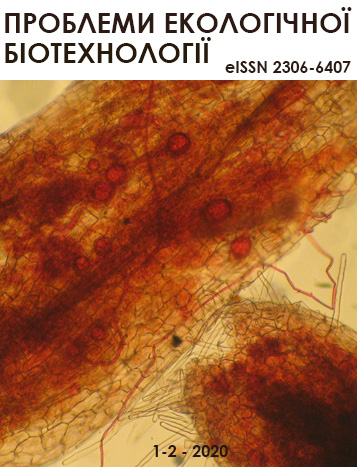Metal-resistant microorganisms of tap water: theoretical justification and biotechnological application
DOI:
https://doi.org/10.18372/2306-6407.1-2.16059Keywords:
filter microbiome, tap water, oxic compounds of chromium and copper, chromium- and copper-resistant microorganisms, environmental biotechnologiesAbstract
Water is one of the most essential resources for all living things. The issue of drinking water quality is acute both in Ukraine and in other countries due to the development of industry, as well as the constant growth of the world's population. After purification and disinfection of water at water treatment plants and then in the water supply system, water quality is not controlled. An important indicator that determines the quality of water is its microbial composition.
Microorganisms get into water mains from water intake sites and live and multiply in outdated and modern systems of drinking water distribution. In the sample of tap water, which was taken from the water supply system of Kyiv, we determined a significant content of microorganisms – 2.45×103 CFU/mL. The number of chemoorganotrophic microorganisms in the filler, which was removed from the filter cartridge for water purification, was also high – 1.6×105 CFU/g. In addition, the filler for water filtration contained thousands and tens of thousands of metal-resistant microorganisms. Thus, the maximum permissible concentration (MPC) of Cu(II) (ionic form) for the microbiome of the filter was 125 ppm, as well as Cr(VI) – 350 ppm. The concentration of living microorganisms in the medium was 2.91×105 CFU/g of filter at the presence of MPC of Cu(II). The number of microorganisms was 9.7×102 CFU/g at the presence of Cr(VI) (in form of CrO42-) in the nutrient medium. The resistance of the microbiome of the water filter to Cu(II) chelated by citrate was investigated, becouse heavy oxidizing metal compounds are able to precipitate in biological media. It was found that the resistance of microorganisms to Cu(II) citrate was 28 times higher than to the ionic unchelated form and amounted to 3500 ppm. The isolated microbiome is polyresistant and has a high adaptive potential to action of toxic metal compounds.
References
Mujahid T.Y. Bacteriological Quality Analysis of Tap Water of Karachi, Pakistan International Journal of Advanced Research / T.Y. Mujahid, K. Siddiqui, R.Z. Ahmed [et al.] // International Journal of Advanced Research – 2015. – 3(2). – Р. 573–578 http://www.journalijar.com
Botsaris G. Microbial quality and molecular identification of cultivable microorganisms isolated from an urban drinking water distribution system (Limassol, Cyprus) / G. Botsaris, L. Kanetis, M. Slanу [et al.] // Environ Monit Assess – 2015. –187 (739) http://dx.doi.org/10.1007/s10661-015-4957-9
Li M. Antibacterial Performance of a Cu-bearing Stainless Steel against Microorganisms in Tap Water / M. Li, L. Nan, D. Xu [et al.] // Journal of Materials Science Technology – 2015. – 31. – Р. 243-251 doi: http://dx.doi.org/10.1016/j.jmst.2014.11.016
Atuanya E.I. Effects of Storage/Biofilm Formation on Physico-chemical and Bacteriological Qualities of Potable Water Supply in Benin City Nigerian / Atuanya E.I, Seidu, R.I., Orjiakor P. // Society for Experimental Biology Journal – 2018. – 14(2) https://doi.org//10.5812/semj.68911.
Roi I.Yu. Species Identification of Water Microorganisms Resistant to Chlorine Compounds / I.Yu. Roi, N.A. Klimenko, G.M. Zdorovenko, V.V. Goncharuk // Journal of Water Chemistry and Technology – 2015. – 37(3) . – pp. 145–150 http://dx.doi.org/10.3103/S1063455X1503008X
Arnaud Florentin MD Water and surface microbiologic quality of point-of-use water filters: A comparative study / Arnaud Florentin MD, MSc, Julie Lizon PharmD [et al.] // American Journal of Infection Control – 2016. – 44(9). – P. 1061–1062 http://dx.doi.org/10.1016/j.ajic.2016.02.028
Khan M.A. Assessment of microbial quality in household water tanks in Dubai, United Arab Emirates / Khan M.A. [et al.] // Environmental Engineering Research – 2017. – 22(1). – Р. 55–60 https://doi.org/10.4491/eer.2016.051
Sadik N.J. Quantification of multiple waterborne pathogens in drinking water, drainage channels, and surface water in Kampala, Uganda, during seasonal variation / N.J. Sadik, S. Uprety, A. Nalweyiso [et al.] // GeoHealth – 2017. – 1(6). – Р. 258–269 https://doi.org//10.1002/2017GH000081.
Charnock C. Diversion and phylogenetic relatedness of filterable bacteria from Norwegian tap and bottled waters / C. Charnock, T.L. Vo, T.N.-T. Nguyen, R.X. Hagen // Journal of Water and Health – 2019. – 17(2) https://doi.org/10.2166/wh.2019.284
Leginowicz M. Biodiversity and antibiotic resistance of bacteria іsolated from tap water in Wrocław, Poland / M. Leginowicz, A. Siedlecka, K. Piekarska // Environment Protection Engineering – 2018. – 44(4) https://doi.org/10.5277/epe180406
Al-Sagur I.M. Investigation of Giardia lamblia and other parasites in tap water as a potential source of transmission in some regions of Baghdad / I.M. A l-Sagur, S.H. Mahmood, H.M.A. Al-Obaidi // Iraqi Journal of Science – 2015. – 56(1). – Р. 337-344
Державні санітарні норми і правила ДСанПіН 2.2.4-171-10 «Гігієнічні вимоги до води питної, призначеної для споживання людиною»


